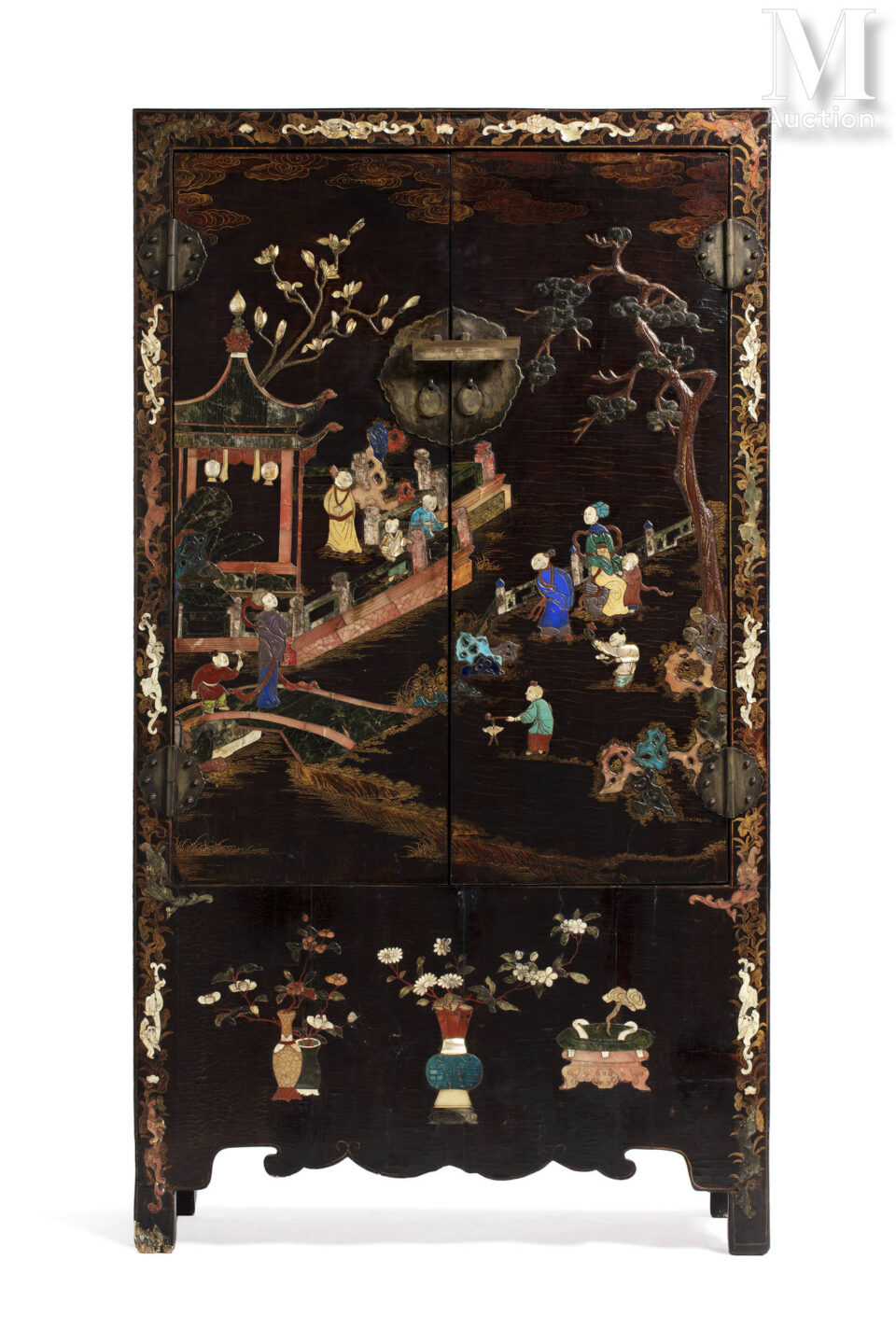All you need to know about Asian lacquer appraisals
Do you own an Asian work of art and would like to appraise it? Our auctioneers and experts specializing in Asian Art will appraise your works of art free of charge and help you sell them at auction.
Receive a confidential estimate for your Asian artworks within 48 hours.
Asian lacquers, whether Chinese, Japanese, Vietnamese or Korean, have seen their value soar in recent years. This is particularly true of Vietnamese lacquers. In Asia, lacquer is used on lacquered panels, screens, religious statues and boxes. A traditional technique, lacquer is still used today by contemporary artists.
Depending on the type of object, its period of creation, provenance, state of conservation and artist, the estimate can be high.
Whether you own a panel, a religious statue or a box, getting an accurate estimate is essential in a rising market.
Lacquer estimates and prices
The Asian lacquer market is very active today, with prices ranging from a few hundred to tens of thousands of euros. Chinese lacquers, particularly those from the Ming and Qing dynasties, are among the most sought-after, as are 20th-century Vietnamese works. Beware, there may be some exceptional records!
| Object type | Period | Price range | Auction examples and results |
| Decorative lacquered panels | Twentieth century | 30 € – 650 000 € | Nguyễn Gia Trí, Village Scene, sold for €375,000; Pham Hau, Halong Bay, €896,000 . |
| Lacquered screens | Twentieth century | 10 000 € – 550 000 € | Nguyễn Gia Trí, Pagoda Chùa Thầy, €400,000 ; |
| Religious lacquer statues | 19th – 20th centuries | 50 € – 75 000 € | Buddha, lacquered wood, Cambodia, 19th century, €26,000; lacquered Buddha, €75,000. |
| Lacquered furniture | 19th – 20th centuries | 500 € – 33 000 € | Lacquered furniture, Maison Thanh Lê, €500; Pham Hau, Panel €33,000. |
| Lacquered boxes and cases | Twentieth century | 100 € – 26 000 € | Pham Hau, Lacquered box: €26,000 ; |
These values can fluctuate according to various factors, such as the state of conservation, the rarity of the object and its provenance. Older works in good condition are highly prized, but modern or contemporary works bearing the signature of a recognized artist can also fetch significant prices.
Why should I have my lacquerware appraised?
Asium offers you a free valuation of your artworks, whatever your needs.
- for insurance purposes, before any accident or following damage
- in the event of an inheritance, you may need a reliable estimate for inheritance tax purposes
- in the event of a division or divorce, our estimate ensures that no party is prejudiced
- out of curiosity, to find out the value of your object
How can I get an estimate for my lacquer with Asium?
You can request an appraisal online via our form, where you can submit photos and descriptions of your works. Asium also organizes appraisal days where you can bring your pieces for an in-person appraisal, as well as in-home appraisal services for larger collections.

Recognize a lacquer to estimate it
To recognize a genuine lacquer, it’s essential to examine several elements:
Techniques and materials
- Surface: A good-quality lacquer has a smooth, glossy finish, often obtained by polishing many layers. On examination, the lacquer has a deep sheen and reflects light evenly.
- Color: Colors should be deep and even, with no visible discoloration.
- Patterns: Carved or painted motifs must be fine and well-defined .
- Condition: visible defects, such as air bubbles or irregularities, may indicate lower quality, or repair.
This examination often enables you to determine the geographical origin of your lacquer.
Signs of authenticity
- Craftsman’s marks: Renowned lacquer craftsmen often leave their mark or signature on their pieces, which can increase their value. For example, a piece signed by an 18th-century Japanese master craftsman will be worth more.
- Certificates of authenticity: Obtaining a certificate of authenticity at the time of purchase is recommended, especially for expensive pieces.
Signature: what impact on the estimate?

Signatures and trademarks
The signature of the craftsman or workshop is a key element in estimating the value of a lacquer piece. It is a key element in determining the authenticity and quality of the work, providing collectors and buyers with indications of the object’s provenance and history.
Importance of signatures :
Pieces signed by master craftsmen are generally considered more valuable. For example, a lacquer vase signed by a renowned craftsman from the Ming dynasty, which reigned from 1368 to 1644, has been estimated at 100,000 euros due to the craftsman’s reputation and the quality of the work.
In China, Jingdezhen craftsmen, in Japan masters like Agota Korin, in Vietnam artists like Nguyen Gia Tri or Pham Hau win major prizes.
Workshop marks :
In addition to individual signatures, some pieces bear workshop marks that can also influence their value.
Condition and provenance: the pluses and minuses of valuation
The state of preservation
The overall condition of the object, including the presence of cracks, retouching or repairs, directly influences its price. For example, a carved lacquer box in perfect condition could fetch 60,000 euros, while a similar piece with defects might be worth just 10,000 euros.
Provenance
A prestigious provenance, such as an imperial collection or a piece that belonged to a royal family, considerably increases the appeal of the work. For example, a lacquered box from the Chinese imperial court doubles its estimate to €75,000 due to its provenance.
A brief history of Asian lacquers
The history of lacquerware in Asia goes back thousands of years. In China, its use dates back to the Neolithic period, when the first lacquer objects were primarily utilitarian. With the passing of the dynasties, lacquer evolved into a refined art form.
- China: The first lacquers were used for wooden containers. Over the centuries, lacquer was perfected to become a luxury art, especially under the Ming (1368-1644) and Qing (1644-1912) dynasties.
- Japan: The art of lacquerware flourished in Japan during the Heian (794-1185) and Edo (1603-1868) periods. Japanese craftsmen developed unique techniques such as makie and kintsugi, which highlight the beauty of imperfections.
- Vietnam: Vietnam has a long tradition of lacquerware, particularly in the Hué region. The son mài technique, which combines lacquer and inlay, was developed in the 20th century and has become a respected contemporary art form.
- Korea: Korean lacquer art, especially during the Joseon dynasty (1392-1910), is known for its elegance and simplicity, often adorned with delicate floral motifs.
The evolution of lacquerware in Asia reflects not only centuries of craft tradition, but also the influence of global artistic trends. Today, antique and contemporary pieces continue to captivate art lovers, as much for their technique as for the cultural heritage they convey. Today’s market is seeing a growing interest in modern lacquerware, particularly Vietnamese, rediscovering a timeless heritage.
Our experts in lacquer
-

TaHsi CHANG
Specialist in the arts of VIETNAM and CHINA
-

Jean GAUCHET
ASIA Expert
-

Eunbi HA
Your questions, our answers
What factors influence the price of an Asian lacquer at an appraisal?
The price of an Asian lacquer depends on a number of factors, such as its state of preservation, provenance, the craftsman’s signature, the manufacturing techniques used and the rarity of the piece on the market.
How do different lacquering techniques affect the value of an object?
Techniques such as carved or inlaid lacquer in China, makie in Japan, and son mài in Vietnam, each with their own complexity and aesthetics, influence value due to rarity and market demand.
How does a lacquer’s provenance affect its appeal to collectors?
Provenance plays a crucial role in a lacquer’s appeal, as pieces from reputable workshops or specific historical eras can be perceived as more authentic and desirable, thus increasing their value on the market.
Previously appraised by Asium
Lacquer estimate, discover also
The Asium estimation service is...

Simple
and free
A few photos of your work, a few words of description and you're all set !

Fast
but not too fast
Our experts are serious, they take the time to research and get back to you within a week.

Reliable
and confidential
Our auctioneers are the Sherlock Holmes of the art market.

















